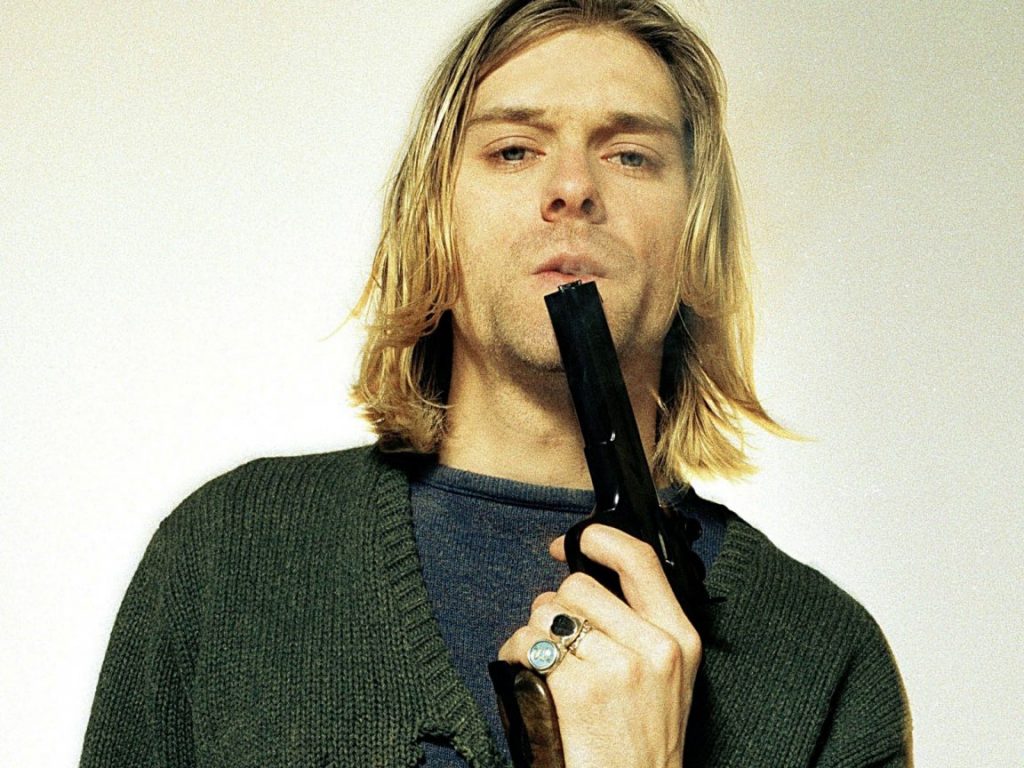“I’m not afraid of dying. Total peace after death, becoming someone else is the best hope I’ve got.” This statement made by Nirvana front-man Kurt Cobain reflects both the self-loathing and general sorrow, or anguish, that he felt he was constantly suffering from and ultimately what led to the tragic event that occurred on April 5, 1994. Kurt Cobain, the lead singer of the band Nirvana, was born in Hoaquiam, Washington on February 20, 1967.1 Few honestly know of the struggles Kurt had to endure in his life, such as his parents’ divorce when he was about nine. This break-up resulted in Kurt losing a permanent place of residence, leaving him in a constant state of borderline homelessness. As a matter of fact, Kurt even resorted to staying at the hospital where he was born around the age of nineteen.2 Regardless, Kurt still managed to climb from rock bottom to become the star he was: the lead singer of Nirvana and the face of grunge music for many people worldwide.

Of course, Nirvana didn’t come straight out the gate making hits nor score international shows. The band Nirvana actually had quite a macabre or fuzzy rise in comparison to other bands. Interestingly enough, Nirvana didn’t even start off being called Nirvana. This small trio actually bounced around with abstract names for quite a few years. From their humble beginnings in Aberdeen, Washington, in 1987 the band was known as Skid Row, Pen Cap Chew, and Bliss all within the same year.3 They played a few house parties and even fewer shows at real venues around the Aberdeen area, but the band life was more of a hobby to the group. They had fun doing what they did, played their hearts out when they had to, but they didn’t really think they were going to be anything huge when they first started out.
The group may have started small, but the effort and time they put into the band would soon enough pay off. In 1989, they released their independent album Bleach, which got them a lot more shows in lots of new places. The band finally started “blowing up” and gathering many followers nationwide. With this newfound momentum, Nirvana signed with Geffen Records and released their second album Nevermind, which has since become legendary. This was just two years after their first independent album Bleach was released.4 Nevermind kicked off Nirvana’s international rise to a new high, scoring them not only shows around the country, but in other countries as well. Nirvana went global and this new, dissonant, and muddy type of rock music started receiving mainstream recognition. This new and quickly popular genre became known and recognized as grunge, a form of punk rock with the muddy sounds of post-punk mixed with a sprinkle of youthful angst.5 This new genre became the sound of the ’90’s, with many bands such as Soundgarden, Pearl Jam, and Alice in Chains riding the wave. But for many worldwide, songs such as “Smells Like Teen Spirit” or most of the songs from Nirvana’s Nevermind album became grunge anthems that depicted the youthful rebellion and dissonance reflected in grunge music.6

Although Nirvana was finally blowing up and rising to international fame quickly, the lead singer Kurt Cobain was still not truly satisfied with his life. Throughout his life, Cobain constantly suffered from stomach illnesses. In response to this constant illness, Kobain would abuse drugs like heroin, claiming it would cure this problem. Even worse, when Kurt met his soon to be mother of his child Kourtney Love, his heroin abuse only got worse.7 With more money and fame, his addiction grew stronger and the pressures of fame and fortune began mounting on his shoulders, until one day it was just too much. In 1994, while on tour in Europe, Kurt had to be hospitalized for drug overdose and other health issues including alcohol problems. Soon after, he was forced to cancel the tour and return back home to Seattle. His family and friends decided to stage an intervention and convince him to admit himself into rehab, much to his displeasure. This rehabilitation did not last long, as Kurt decided to flee the rehab center and return back home to Seattle, tragically unbeknownst to his family and friends. On April 8, 1994, an electrician found Kurt Cobain’s dead body in a room above the garage above his home where he was hiding out at.8 The cause of death was a self-inflicted shotgun blast to the head, and even worse, heroin was found in his system so it’s not even clear if Cobain really meant to do that to himself or if the drugs influenced him to do so.9
Cobain’s inconceivable and unanticipated death resulted in worldwide mourning over the loss of this young artist’s life. Family and friends, especially his girlfriend and daughter, were heavily affected by this tragedy, as well as all of his listeners. Cobain was an icon for Generation X. He gave voice to the youthful generation of people that felt they were dealt a bad hand. He encouraged the generation, and became “the poster boy for grunge.” After Kurt’s death, the grunge scene died down quickly. Of course, there were still other bands in the genre putting out a few successful albums, but the genre never saw the fame and glory it had during its heyday in the early ’90’s, when Nirvana was contributing to the movement.10 The genre died out as quickly as it was born, with the untimely and very unfortunate death of a very talented and tormented young artist.
- Salem Press Biographical Encyclopedia, 2013, s.v. “Kurt Cobain,” by Delbert S. Bowers. ↵
- Nick Soulsby, I Found My Friends: The Oral History of Nirvana (New York : Thomas Dunne Books/St. Martin’s Griffin, 2015). 7. ↵
- Salem Press Encyclopedia, 2013, s.v. “Nirvana (music),” by Alan Haslam; Nick Soulsby, I Found My Friends: The Oral History of Nirvana (New York : Thomas Dunne Books/St. Martin’s Griffin, 2015), 1-18. ↵
- Salem Press Encyclopedia, 2013, s.v. “Nirvana (music),” by Alan Haslam. ↵
- Baker’s Biographical Dictionary of Popular Musicians, 2004, s.v. “Grunge: A Brief History of a Hard Rock Genre,” by Gil Kaufman. ↵
- Baker’s Biographical Dictionary of Popular Musicians, 2004, s.v. “Grunge: A Brief History of a Hard Rock Genre,” by Gil Kaufman. ↵
- Salem Press Biographical Encyclopedia, 2013, s.v. “Kurt Cobain,” by Delbert S. Bowers. ↵
- Salem Press Biographical Encyclopedia, 2013, s.v. “Kurt Cobain,” by Delbert S. Bowers. ↵
- Salem Press Encyclopedia, 2013, s.v. “Nirvana (music),” by Alan Haslam. ↵
- Baker’s Biographical Dictionary of Popular Musicians, 2004, s.v. “Grunge: A Brief History of a Hard Rock Genre,” by Gil Kaufman. ↵



112 comments
Rebecca Campos
The article had more a biographical feel to it. It was very informative and offered information that I had never known about Kurt Cobain. I listen to Nirvana fairly often so it was interesting to learn about the beginnings of the band and the trials endured in the process of making a name for themselves. The issue of drug addiction is so prominent in today’s society and it’s unfortunate that tragic ends like Kurt Cobain’s hasn’t been enough to cease the abuse of drugs we see today. Maybe in the future more people will see just how bad the toll of drugs can have on potentially long, successful lives.
Kristy Feather
I absolutely loved this article! As a hardcore punk-rock and grudge fan it is so amazing to just read about one of the leading roles in creating the genre. Although I don’t listen to Nirvana much, Kurt Cobain’s story is so similar to other punk band’s members that it’s hard not to wonder if this type of music is from the soul or from the suffering that most of the musicians have to go through. Although I think there are other ways to fight pain than drug addiction, I can’t even fathom the sadness that comes from never having a home or childhood.
Montserrat Moreno Ramirez
This was so interesting to learn since I was never a fan of the band I never really had a chance to know the real journey of the band, but getting to know how this story was coming to live and how the childhood of the characters could influence that much in the way they behave was so interesting but also really sad and shocking, I can’t believe the effect that drug abuse can have on a man that just leads him to do crazy things and even forget about their family.
Jennifer Salas
I never knew the depth of Kurt Cobian’s childhood and drug addiction. I’ve listened to Nirvana since I was a kid and I’ve always felt connected to their music, but I never knew the battles they were facing behind the scenes. This shows that money and fame don’t make your problems disappear but magnifies it. At the top of the bands career Cobian was battling his inner demons and used drugs and alcohol to deal with it. Unfortunately, Cobian took his own life and although he had a short career Nirvana is still one of the most loved and influential bands.
Bictor Martinez
I always loved listening to Nirvana’s music, but I never knew the conflicts the lead singer had. Despite all the fame and glory he had, it didn’t really mean anything to him as he continued to do drugs and felt dissatisfied. It seemed as if Kurt’s problem could not be cured no matter what he got out of life. This comes to show how one person’s self spirit and confidence is everything because if you have a low self spirit and confidence then you will never be satisfied with your life even if you may have all the money in the world.
Hailey Stewart
I recently had a conversation with my peers about how artists often create their best work during their lowest times, but we as a society, are sometimes discontent with what they produce when they’re at their happiest. This wasn’t necessarily the case with Cobain, however, I’d argue that his legacy through Nirvana was Sublime. To see someone so visible to the public eye be so open about their struggles helps us through our hard times as well.
Alexandria Zapata
I have always loved Nirvana and how they start out. Kurt Cobain was an inspiration to everyone living at the time, (and even now really) because he helped kick start a music genre that was not really known for at his time. He created a sound that most people could listen to and enjoy. He helped out many people who felt like they “got dealt a bad hand”. Cobain became the “poster boy for grunge” and everyone knew of him. I love the article and how well it was written, by flowing nicely into the details.
Maisie Favila
As someone who likes listening to Nirvana, i found this article interesting because I got to know Kurt on a better level. I do feel as if his death lead to other metaphorical deaths in the music industry. He took the whole grunge scene with him. His music really spoke loudly about his life and it impacted tons of people. They are easily one of the most well known bands still today.
Alexis Martinez
I have been a huge fan of Nirvana since I was a young girl. This article did a great job of highlighting Cobain’s angst and overall mental state throughout his career. I really enjoyed how you went into depth regarding his struggles with drug abuse, I relate to that from seeing friends of mine struggle with it. The beginning especially was enticing and kept me wanting to read more.
Mariah Cavanaugh
My inner angsty teen thoroughly enjoyed reading this article. I grew up in the 90’s listening to Nirvana and was devastated by his suicide. Your story ends with Kurt referred to as a “tormented young artist,” he never tried to hide that persona, and it played into the grunge lifestyle and appealed to the fans. I think you were right when you pointed out that the grunge scene died along with Kurt Cobain.